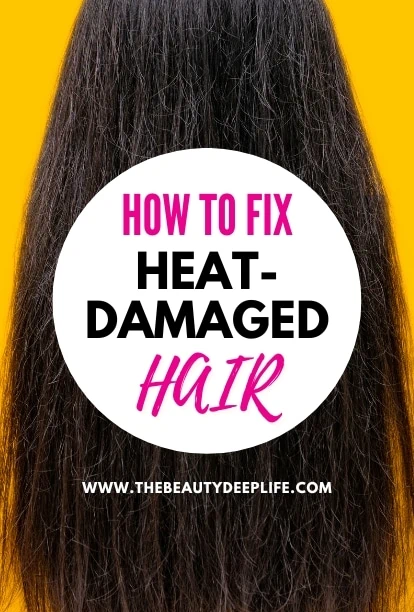
Hair damage is like that friend who always shows up uninvited – especially for those who regularly subject their tresses to the rigors of heat styling. From blow dryers to flat irons, these styling tools can turn your mane into a drama queen with issues like dryness, brittleness, and split ends. But despair not, for there are effective ways to treat and repair your heat-damaged hair.
In this guide, we’ll explore the best methods and products to breathe new life into your locks! Whether you’re a straightening iron enthusiast or simply looking to reverse the damage done, this post is tailored to provide a wealth of solutions to rescue those frazzled locks from the fiery wrath of heat damage!
This article has affiliate links, which means I may receive a small commission if you purchase with those links (at no extra cost to you). For more information, please see our Disclosure Policy Page. As an Amazon Associate, I earn from qualifying purchases.
Understanding Heat-Damaged Hair
Before you can fix a problem, it’s crucial to understand its nature, right? Well, Beauties, heat damage occurs when the cuticles of your hair— the protective layers that guard the inner strand—are cracked and lifted by high temperatures.
This breakdown of the cuticle layer leads to the exposure of your hair’s inner structure, the cortex, which holds essential protein and moisture. When this occurs, hair can’t hold onto moisture, leading to dry and brittle strands.
Additionally, the protein that makes up your hair is called keratin. High temperatures alter the hair’s keratin structure, making it weaker, and disrupt the bonds in your hair, which are responsible for its strength and elasticity.
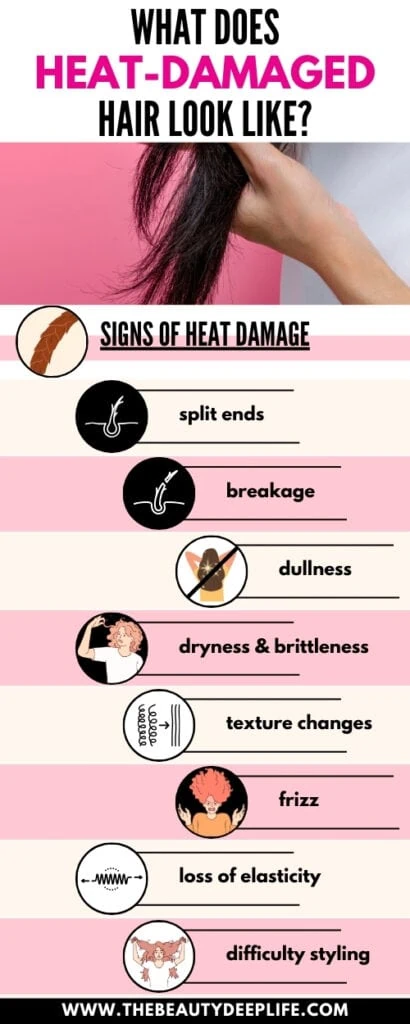
What Does Heat-Damaged Hair Look Like?
Let’s highlight the most common signs of heat damage, from how it looks to how it feels…
- Split Ends: When the cuticle becomes damaged, it can start to fray at the ends of the hair strands.
- Breakage: Heat damage weakens the hair shaft, making it more fragile, so there may be visible breakage, such as fly-aways (shorter hairs that stand up).
- Dullness: Hair is stripped of its natural shine, leaving it looking lackluster.
- Dryness & Brittleness: Heat-damaged hair often appears & feels dry and brittle. It’s usually rough to the touch due to moisture loss.
- Texture Changes: Prolonged exposure to heat can alter the natural texture of the hair. For example, curly hair may become looser or lose its curl pattern.
- Frizz: The lack of moisture in heat-damaged hair can make it frizzy and unmanageable.
- Loss of Elasticity: Healthy, bouncy hair has good elasticity, as it can stretch and return to its original shape without breaking. By contrast, heat-damaged hair may lose its elasticity, feel stiff, and be more prone to snapping when stretched.
- Difficulty Styling: Heat-damaged hair may be more challenging to style as it lacks smoothness and may not hold styles well. It may also be more prone to tangling and knotting.
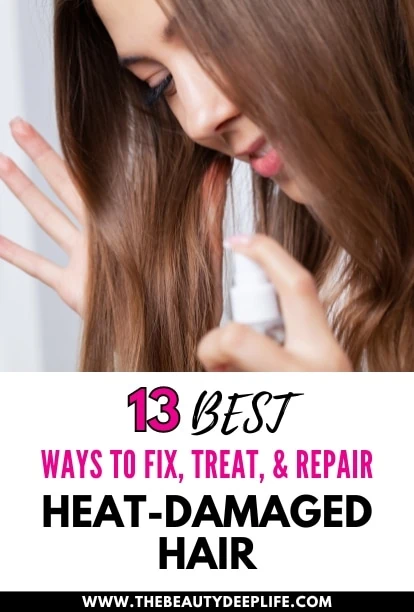
The 13 Best Ways To Fix, Treat, & Repair Heat-Damaged Hair
Okay, your hair’s given you the silent scream for help with the heat damage. Now it’s your turn to show your love. Here are the top 13 methods to fix, treat, repair, and protect your hair from the perils of heat styling, gals!
1) Ditch The Sulfates, Folks!
They may give you that satisfying lather, but they also strip your hair of moisture, leaving it dry and brittle. Opt for a sulfate-free shampoo to gently cleanse your strands without adding fuel to the fire. Consider choosing a shampoo specifically formulated for damaged hair to help repair, strengthen, and restore your locks to their former glory.
However, if you’re experiencing a lot of dryness, go for sulfate-free moisturizing shampoo like this one from Alterna. Your hair deserves the best care to maintain its health and vitality.
A FEW PRO TIPS FOR WASHING HEAT-DAMAGED HAIR:
- Ease Up on the Lather: It might feel counterintuitive, but lathering up every day can do more harm than good. Frequent shampooing strips away the scalp’s natural oils, which actually protect your hair and keep it hydrated. To prevent exacerbating heat damage, try to shampoo once a week if you can, or just two times a week at the maximum. This will allow your hair’s natural oils to do their restorative work and result in a healthier sheen in the long run.
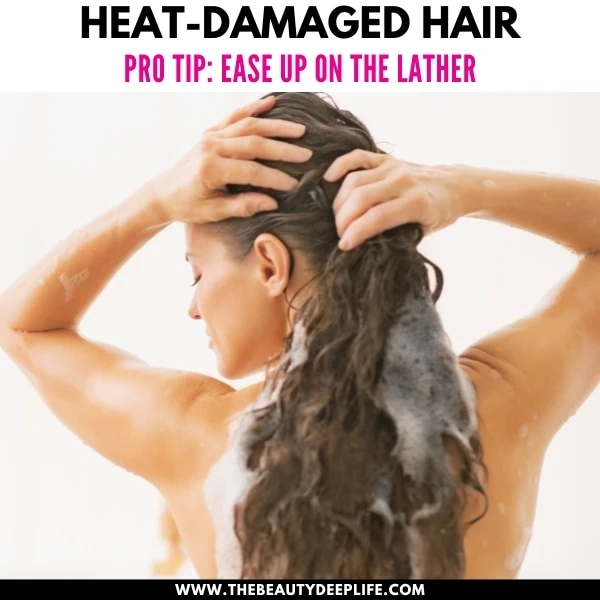
- Target the Foundation, Not the Fragile – Mind Your Mane’s Mid-Lengths and Ends: Pay attention to where you apply shampoo. Your roots and scalp produce oil and build up dirt, needing the most cleaning. Let suds slide down to the middle and ends as you rinse, rather than applying shampoo directly to these more damaged areas. Allowing your shampoo to simply wash over the lengths during rinsing will give the ends a break from stripping suds and help maintain moisture.
2) Deepen Your Love With Deep Conditioning Treatments
Conditioning isn’t just a luxury; it’s a necessity, especially for heat-damaged hair. A deep moisture-rich conditioning treatment or hair mask used once or twice a week can work wonders in restoring lost moisture and nourishing your strands. They help hydrate dry, parched strands, improving the overall look and feel of the hair, all while making it more manageable. I guarantee your locks will thank you for the extra care and attention!
Generally left on for anywhere from 5 to 20 minutes, these types of products give ample time to penetrate deeply into the hair shaft, allowing your mane to soak in all their restorative goodness. Look for ingredients such as hydrating oils (e.g., argan oil, coconut oil, avocado oil, jojoba oil), conditioning agents (e.g., shea butter, panthenol), and humectants (e.g., glycerin, hyaluronic acid, honey), that help attract and retain moisture in the hair shaft.
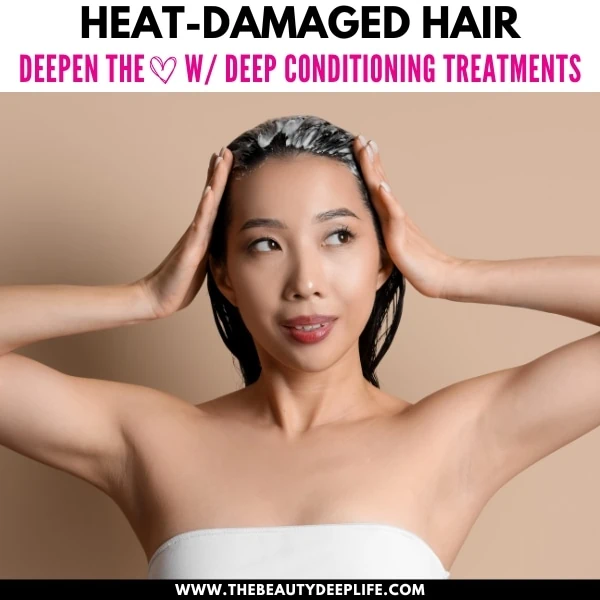
*Keep in mind when picking deep conditioners and hair masks that while some are moisture-based, others can be protein-based or have a combo of both protein and moisturizing ingredients.
Product Recommendations:
- Amika Soulfood Nourishing Hair Mask – Hair Type: Fine, Medium, Or Thick / Hair Texture: Straight, Wavy, Curly, Or Coily
- Moroccanoil Intense Hydrating Hair Mask – Hair Type: Medium Or Thick / Hair Texture: Straight, Wavy, Curly, Or Coily
- Amika Hydro Rush Intense Moisture Mask with Hyaluronic Acid – Hair Type: Medium Or Thick / Hair Texture: Wavy, Curly, Or Coily
- COLOR WOW Money Masque – Deep Hydrating Conditioning Treatment (both protein & moisture based, but a low amount of protein) – Hair Type: Fine, Medium, Or Thick / Hair Texture: Straight Or Wavy
3) Trim The Drama Out
Out with the old, damaged bits, in with the fresh new ends. Regular trims, around every 6-8 weeks, will keep the damage at bay, and your split ends in the rear-view mirror. So schedule that salon appointment and snip away the stress!
4) Treat Your Tresses To A Protein Power-Up
These power-packed treatments work by replenishing the hair shaft with protein and filling in the gaps along your cuticle that have been left exposed by excessive heat. Think of them like a superhero swooping in to save the day – they repair, strengthen, and fortify heat-damaged hair, minimizing breakage and split ends.
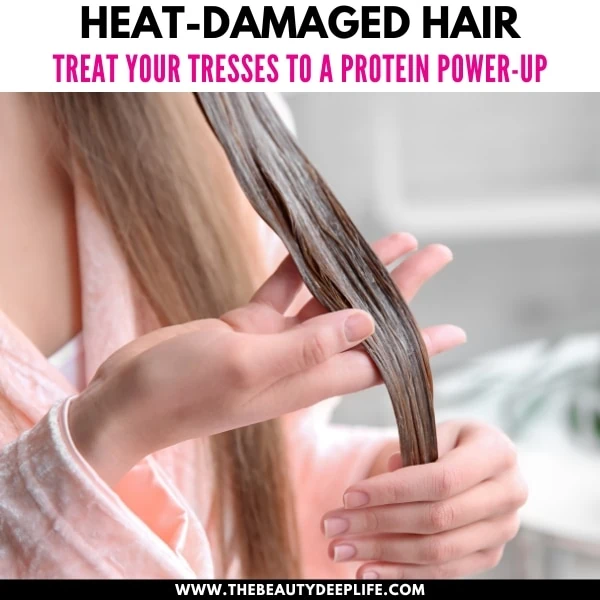
At-home protein treatments come in various forms, from deep-conditioning masks to leave-in treatments, and their frequency of use depends largely on the extent of your hair damage. Overuse can lead to protein overload, which, unfortunately, can leave your locks feeling stiff and brittle, so finding the right balance is key.
Depending on the product type, typically, every 4 weeks is a good rule of thumb. However, some find success starting with once a week or every other week and then tapering off to once a month for maintenance. Opt for treatment products featuring ingredients like hydrolyzed protein, collagen, amino acids, or keratin for that extra oomph.
Product Recommendations:
- Kerastase Resistance Force Architecte Hair Mask– Hair Type: Fine, Medium, Or Thick / Hair Texture: Straight, Wavy, Curly, Or Coily
- Briogeo Don’t Despair, Repair! Mask – Hair Type: Fine, Medium, Or Thick / Hair Texture: Straight, Wavy, Curly, Or Coily
- Joico K-PAK Deep-Penetrating Reconstructor – Hair Type: Fine, Medium, Or Thick / Hair Texture: Straight, Wavy, Curly, Or Coily
- Virtue Keratin Restorative Treatment Mask – Hair Type: Fine, Medium, Or Thick / Hair Texture: Straight, Wavy, Curly, Or Coily
- Redken Extreme Anti-Snap Leave-in Treatment – Hair Type: Fine, Medium, Or Thick
5) Reinforce With Bond Builders
In the hair care realm, bond builders are the unsung heroes working oh so diligently behind the scenes to protect and restore your hair’s integrity. Unlike protein treatments, they’re designed to go beyond the surface, working at the molecular level and delving into the hair’s cortex to repair and reconnect the bonds broken by heat styling. By doing so, they dramatically reduce breakage, ultimately giving it strength and resilience.
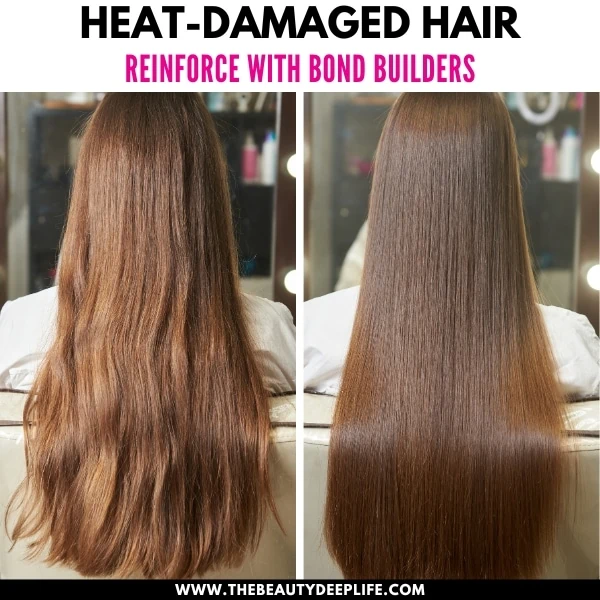
You can choose a bond-building treatment to apply to your heat-damaged tresses at home since they range from hair masks to leave-ins or ask your hairdresser about incorporating it into your salon appointments.
Product Recommendations:
- Olaplex Hair Perfector NO. 3 – Hair Type: Fine, Medium, Or Thick / Hair Texture: Straight, Wavy, Curly, Or Coily
- K18 Biomimetic Hairscience Leave-In Molecular Repair Hair Mask – Hair Type: Fine, Medium, Or Thick / Hair Texture: Straight, Wavy, Curly, Or Coily
- REDKEN Acidic Bonding Concentrate Leave-In Conditioner – Hair Type: Fine, Medium, Or Thick / Hair Texture: Straight, Wavy, Curly, Or Coily
- Living Proof Triple Bond Complex – Hair Type: Fine, Medium, Or Thick / Hair Texture: Straight, Wavy, Curly, Or Coily
6) Heat Protectant Products, Your Lock’s Guardian Angel
Prevention is the best medicine – and in this case, a good heat protectant is the medical professional you want on speed dial. Gently coat your hair with a reputable heat protectant spray or serum before reaching for your styling tools.
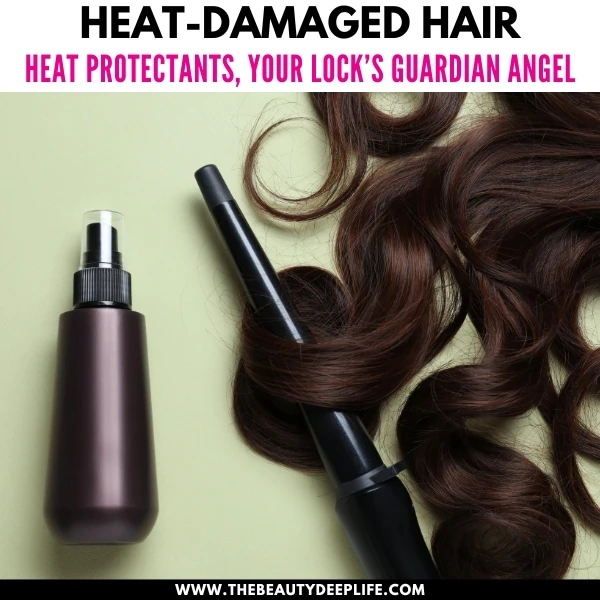
These fantastic products create a shield between your hair and heat, reducing the risk of future damage and helping to preserve your hair’s precious moisture balance. Spray, spritz, or smooth on your heat protectant before blow-drying, curling, or straightening to keep your hair looking and feeling its best.
Product Recommendations:
- Kenra Platinum Blow-Dry Spray | Time-Saving Heat Protectant – Hair Type: Medium Or Thick
- Kenra Platinum Blow-Dry Mist | Ultra-Lightweight Thermal Protectant – Hair Type: Fine Or Medium
- Olaplex No. 9 Bond Protector Nourishing Hair Serum – Hair Type: Fine, Medium, Or Thick / Hair Texture: Straight, Wavy, Curly, Or Coily
- KERASTASE Resistance Ciment Thermique Hair Serum and Blow Dry Primer – Hair Type: Fine, Medium, Or Thick / Hair Texture: Straight, Wavy, Curly, Or Coily
7) Heatless Hair Days Are The Best Days
Give your heat-damaged hair a break from the high temperatures every now and then. Embrace those natural hair days by air-drying your locks and trying out some heatless hairstyles, such as braids, buns, or twists.
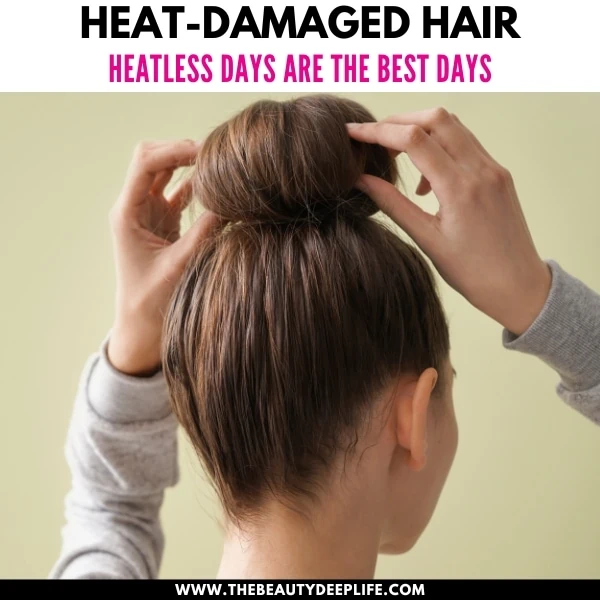
You could also opt for loose waves or curls created through overnight methods. Styling damp hair with rollers or flexi rods can create lovely curls without the need for heat. These methods are gentler on your strands and can create a more unique and natural-looking texture.
Product Recommendations:
- Kitsch Satin Heatless Curling Rod Headband Overnight Curling Set
- Kitsch Heatless Curling Rod Curlers for Short Hair
8) Practice Proper Styling Manners
Gentle is the name of the game, as your goal ultimately is to prevent doing further harm to your mane. So, if you can’t resist the allure of heat styling, consider using lower temperatures and again pair with a heat protectant.
You should also always keep your styling tool moving to avoid exposing any one section of hair to prolonged heat. This will help minimize damage and give your hair a chance to recover while still achieving the look you desire.
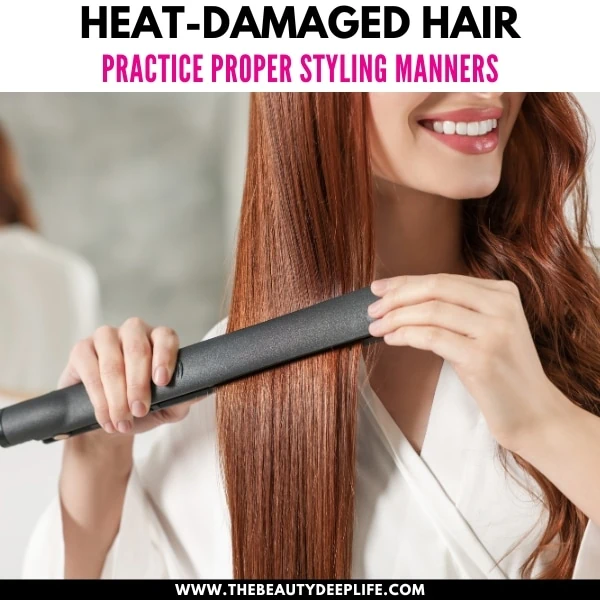
9) Handle Heat-Damaged Wet Hair With Care
When your hair is wet, think of it as a delicate flower – treat it with care! Wet strands are much more fragile and susceptible to breakage. To detangle, grab a wide-tooth comb like this one – it’s your best ally, working through knots like a charm without the tug-of-war. And when it’s time to dry, bypass the rough-and-tumble towel rub for a gentle wrap in a microfiber towel, your hair’s new best friend.
Here’s a PRO TIP: Let your locks air-dry while you’re bustling around the house. Not only will you cut down on drying time, but you’ll also give your hair a much-needed break from the heat. It’s a win-win for you and your mane, sparing it from the harshness of blow-drying and keeping those strands singing your praises.
10)Choose Wisely: Heat Styling Tool Selection
Choose tools that are kinder to your hair. Look for those that offer adjustable heat settings, which allow you to cater to your hair’s particular needs.
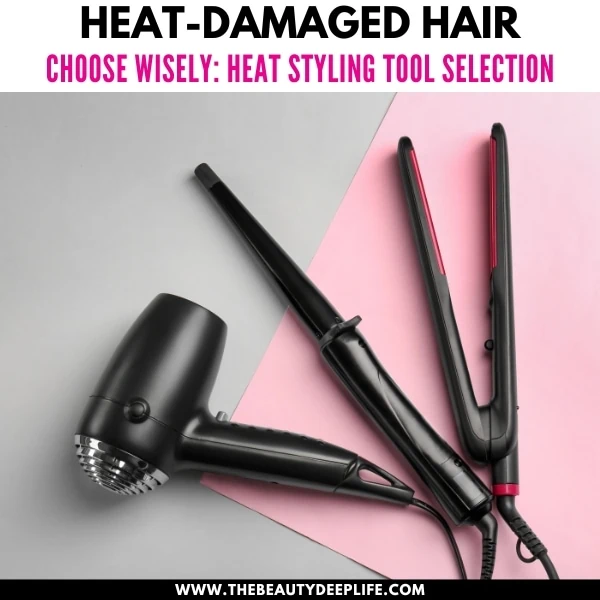
- Tool Talk: Invest in high-quality styling tools that can regulate temperature. The flimsy, the funky, and the fly-by-night tools are no bueno.
- Ionic, Tourmaline, & Ceramic: These materials are your allies in the heat battle. Ceramic plates can distribute heat more evenly, preventing hot spots which can lead to damage. Ionic and tourmaline help seal the cuticle to lock moisture in, which is a must when dealing with heat-damaged hair. Tourmaline also helps reduce frizz and shortens drying time when used for hair dryers.
- Steam-Powered: Or you could give hair-steaming tools a whirl! These innovative gadgets use steam to infuse your hair with moisture while you straighten or curl, making them a gentler option for heat-damaged tresses.
Product Recommendations:
- FHI HEAT Platform Pro Styling Tourmaline Hair
- Paul Mitchell Pro Tools Express Ion Smooth+ Ceramic Flat Iron
- CONAIR INFINITIPRO Tourmaline Ceramic 1-Inch to 1/2-Inch Curling Wand
- Remington Damage Protection Hair Dryer with Ceramic + Ionic + Tourmaline Technology
- Hot Tools Pro Artist 1875W Turbo Ceramic + Ionic Hair Dryer
- Hot Tools Pro Signature Steamstyler
11) Protect Your Hair While Sleeping
Believe it or not, even your sleep can affect the health of your hair. Cotton pillowcases can create friction and cause breakage, so opt for satin or silk instead.
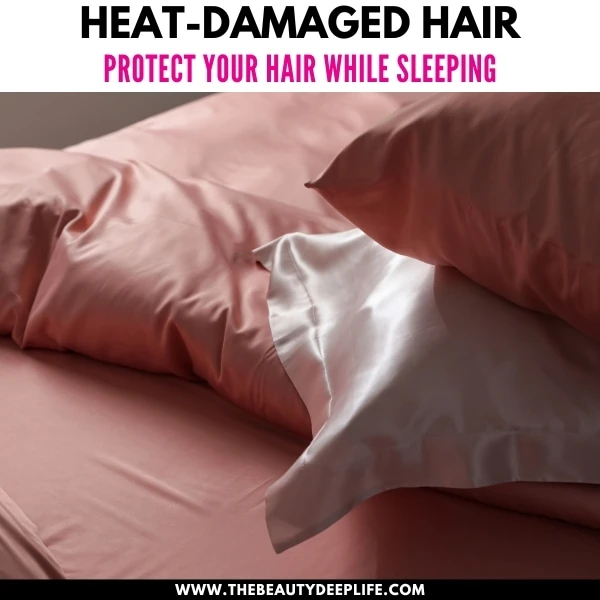
It’s also a great way to reduce moisture loss while keeping your hair smoother and more manageable in the morning. You can also try a silk (or satin) bonnet or hair scarf to protect your locks while you snooze.
Product Recommendations:
12) Natural Oils: The Holy Grail Of Restoration
If you haven’t jumped on the natural oil bandwagon, now is the time. Natural oils can be a game-changer for those with heat-damaged hair, each possessing unique properties that cater to its needs, from restoring moisture to smoothing the hair cuticle, bringing back its natural shine, strengthening, and rejuvenating softness.
Here’s a quick rundown of just a few of the best natural oils to bring heat-damaged hair back to life…
- Coconut Oil: A true powerhouse, coconut oil not only prevents protein loss but also penetrates the hair shaft to mend and moisturize from within. It’s a go-to for fortifying and hydrating your locks.
- Argan Oil: Loaded with vitamins, minerals, and antioxidants, argan oil is your ally in combating dryness, reducing frizz, smoothing cuticles, and bringing a luminous shine to your mane.
- Jojoba Oil: Mirroring the natural oil produced by your scalp, jojoba oil hydrates without heaviness, making it perfect for mending and maintaining hair’s optimal health.
- Sweet Almond Oil: With a light texture and nutrient-rich profile, sweet almond oil offers a boost of nourishment, strength, and sheen, enhancing the texture and appearance of your hair.
- Avocado Oil: Renowned for its deep-moisturizing capabilities thanks to a rich array of vitamins, minerals, and fatty acids, avocado oil can add nourishment and boost moisture while returning softness and shine to heat-damaged hair.
- Olive Oil: Olive oil, with its abundance of antioxidants and vitamins, stands out for its ability to repair and replenish moisture, reduce breakage, restore softness, enhance shine, and elevate the elasticity in your strands.
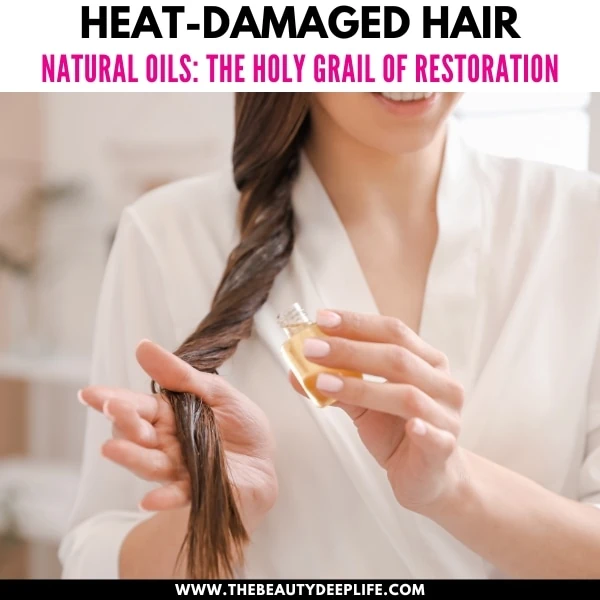
Incorporating these natural oils into your routine can transform the way your hair feels and looks, aiding in its recovery from heat damage. Use them as a pre-shampoo treatment, or perhaps try adding a few drops to some shampoo and conditioner for an additional boost of moisture. Remember, a little goes a long way. Start with small amounts to see how your hair responds, adjusting based on its needs.
Product Recommendations:
- NOW Solutions Liquid Coconut Oil
- Viva Naturals Organic Coconut Oil
- COCO & CO. RAW & Organic Coconut Oil
- Josie Maran Pure Argan Oil
- NOW Solutions Jojoba Oil
- NOW Solutions Sweet Almond Oil
- NOW Solutions Avocado Oil
- KORRES Olive 3-in-1 Nourishing Oil (Use on the ends of hair)
13) Do-It-Yourself Damage Control
Sometimes, the best remedy is right in your pantry! For the more hands-on individual, DIY hair masks can be a great way to nourish and repair your heat-damaged hair. They’re fun to mix up, and the results will make you a hair chef convert. Here are a few ingredients to look for when whipping up concoctions:
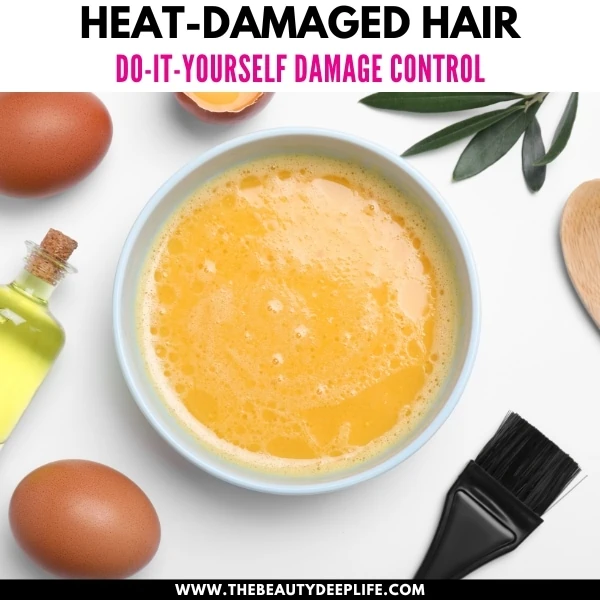
- Natural Oils: Refer to suggestions in #12
- Eggs: Rich in protein, eggs can help strengthen and restore damaged hair.
- Honey: A natural humectant, honey helps lock in moisture and promote healthy hair growth.
- Avocado: Packed with vitamins, minerals, and essential fatty acids, avocado can nourish and hydrate heat-damaged hair.
- Milk: The proteins and fats in milk can help strengthen and moisturize dry, brittle hair.
- Banana: Rich in vitamins and minerals, bananas can help nourish and repair damaged hair.
Essential Product Tips For Heat-Damaged Hair
Those with heat-damaged hair can benefit from products that are either moisture-rich, protein-based or a combination of both. Here are a few things to keep in mind when using these products, whether it’s a leave-in, conditioner, mask, etc…
Product Usage Recommendations:
- Frequency: Alternate between moisture-rich and protein-based treatments to provide a balanced approach to hair repair. Using moisture-rich products more frequently can help maintain hydration levels in the hair. Incorporating protein treatments can strengthen and repair the damaged hair shaft.
- Observation: Pay attention to how your hair responds to different treatments. If your hair feels excessively dry, focus on incorporating more moisture-rich products into your routine. However, if your hair feels weak and prone to breakage, prioritize protein-based treatments.
Ultimately, finding the right balance of moisture and protein is vital to restoring the health and vitality of heat-damaged hair. Trying out different products and taking note of how your hair responds can help you tailor your hair care regimen to meet its specific needs.
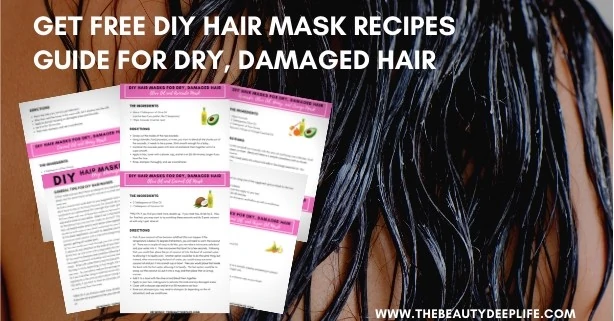
CLICK HERE TO GRAB A COPY OF OUR FREE DIY HAIR MASK RECIPES GUIDE FOR DRY, DAMAGED HAIR
Conclusion: Patience Is A Virtue, Not A Vise
Fixing heat-damaged hair is not an overnight sensation. Patience and consistency are your prowesses. Stick to a routine, be gentle with your hair, and most importantly, keep the faith. Your strands will come out stronger, shinier, and healthier on the other side. Remember, you’re not just fixing hair; you’re giving life to your crown. Keep at it, and you’ll soon be flipping that mane with the confidence of a glamorous goddess! 🌟
Now that you have a comprehensive guide on repairing heat-damaged hair, it’s time to put these insights into practice. Start your repair regimen today! With each little step, you’ll be closer to hearing those loving locks whisper their thanks. Walk with your head as high as your hair once more. It’s your time to shine!
Additional Hair & Beauty Articles:
- 15 Simple Ways to Grow Hair Faster and Thicker
- 7 Simple DIY Hair Masks For Dry Damaged Hair
- Curly Hair Must-Haves: 12 Hair Products Absolutely Worth The Hype!
- The 7 Most MIRACULOUS Conditioners For Dry Hair Repair
- Best Hair Oils For Fine Hair: Healthier Hair’s Just A Drop Away!
- How To Add Serious Volume To Fine Hair: Best Hacks & Products
We are a participant in the Amazon Services LLC Associates Program, an affiliate advertising program designed to provide a means for us to earn fees by linking to Amazon.com and affiliated sites. For more info, see Disclosure Policy.
